Max Mercury and Plenty of Planets, an Absent Moon Allows More Meteors and a Perseus Perusal, and Splaining the Solstice!
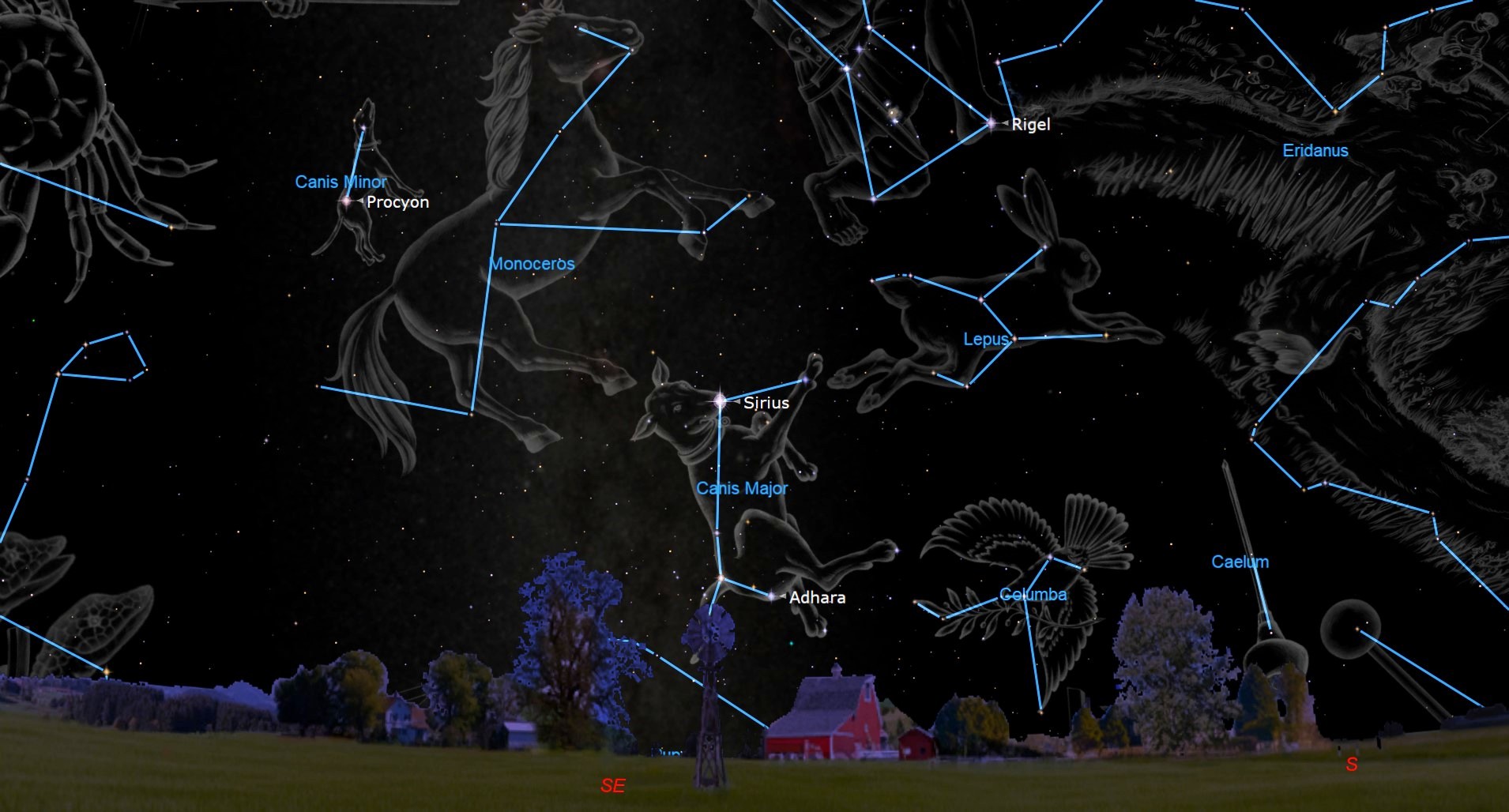
When the very bright “dog star” star Sirius (aka Alpha Canis Majoris) climbs high enough to clear the treetops around 10 pm local time on Christmas, its intense light and flashes of festive colour are bound to catch your eye, and just might fill you with Holiday spirit!
Happy Hanukkah and Winter Solstice, Stargazers!
Here are your Astronomy Skylights for the week of December 18th, 2022 by Chris Vaughan. Feel free to pass this along to your friends and send me your comments, questions, and suggested topics. You can also follow me on Twitter as @astrogeoguy! Unless otherwise noted, all times are expressed in Eastern Time. To subscribe to these emails please click this MailChimp link.
If you’d like me to bring my Digital Starlab portable inflatable planetarium to your school or other daytime or evening event, or deliver a session online, contact me through AstroGeo.ca, and we’ll tour the Universe, or the Earth’s interior, together! My terrific book with John A. Read entitled 110 Things to See With a Telescope is a guide to viewing the deep sky objects in the Messier List – for both beginners and seasoned astronomers. DM me to order a signed copy!
The Earth’s northern pole tipping away from the sun triggers the solstice and our passage through Comet Tuttle’s debris makes meteors streak from Ursa Minor. All the planets are observable in evening, I share some cold weather observing tips, and we take a trip through the treats of Perseus. Read on for your Skylights!
Hanukkah and the Jewish Calendar
Astronomy is a secular science – but there is plenty of astronomy embedded within religious and cultural traditions around the world. Hanukkah, or the Festival of Lights, is observed for eight nights and days, starting at sunset on the 25th day of the ninth Hebrew month Kislev. The Jewish lunisolar calendar uses the first appearance of the young, crescent moon to begin a month. Nissan, the first month in the Jewish calendar, begins with the new moon following the March Equinox, placing Kislev into late November to late December in the Gregorian calendar. Kislev began with the last new moon, on November 23, so Hanukkah commences tonight, Sunday, December 18 and ends on sundown on Monday, December 26.
‘Tis the Seasonal Change
Happy Holidays, everyone! Or, as we astronomers say, “Have a Happy Solstice and a Merry Perihelion!”
The December solstice, or winter solstice, will officially occur on Wednesday, December 21 at 21:48 Greenwich Mean Time (or 4:48 pm EST and 1:48 pm PST). At that time, the northern pole of Earth’s axis of rotation will be tilted by its maximum amount of 23.5° away from the sun. The solstice marks the beginning of winter for the Northern Hemisphere – but not winter weather, as I’ll discuss below. On the day of the winter solstice, the sun’s highest point in the daytime sky, which always occurs at local noon, is lower than on any other day of the year. That is because the sun is farthest south of the celestial equator. (An object’s highest position in the sky is called its culmination.)
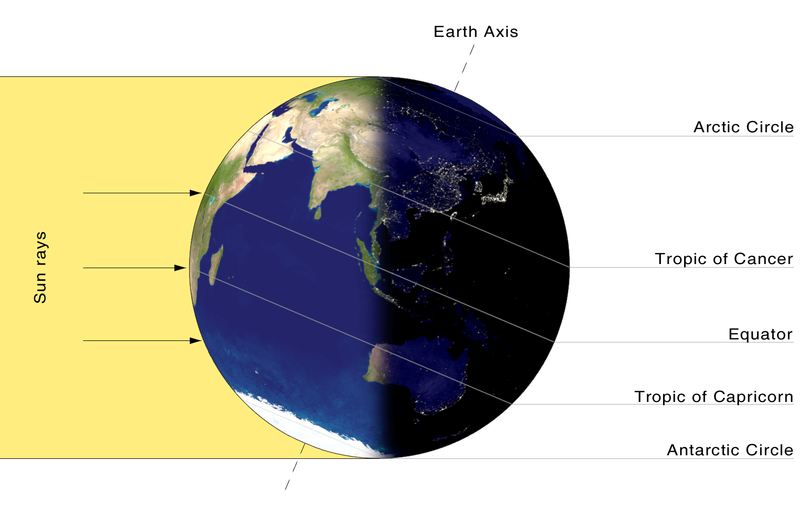
Astronomically, the sun will reach its greatest southern declination and its greatest angle from the celestial equator. The observation that the sun was ceasing to vary in declination (its north-south component of motion compared to the fixed stars) on that date is reflected in the name solstice, which arises from the Latin expression sol sistere, ”the sun is standing still”.
At the December solstice, the points on the horizon where the sun rises and sets are shifted well south of east and west, so the arc that the sun traces out across the daytime sky is shorter than on any other day of the year. Therefore needs much less time to make that crossing. With noon still pinned at mid-day, it’s the sunrise and sunset times that are later and earlier, respectively – so Northern Hemisphere dwellers receive the shortest duration of daylight and the longest nights for the year.
The arc of the sun’s path continues to shorten if you move farther north on Earth – until you reach the Arctic Circle at 66°33′48.4″ North latitude. Anywhere along that ring around the Earth, the sun won’t rise at all on the solstice – but you would still see a twilit sky during the noon hour. Residents living above about latitude 80° N experience 24 hours of darkness, which lasts until the sky begins to brighten ahead of the March equinox. That is great for astronomy – if you can stand the cold!
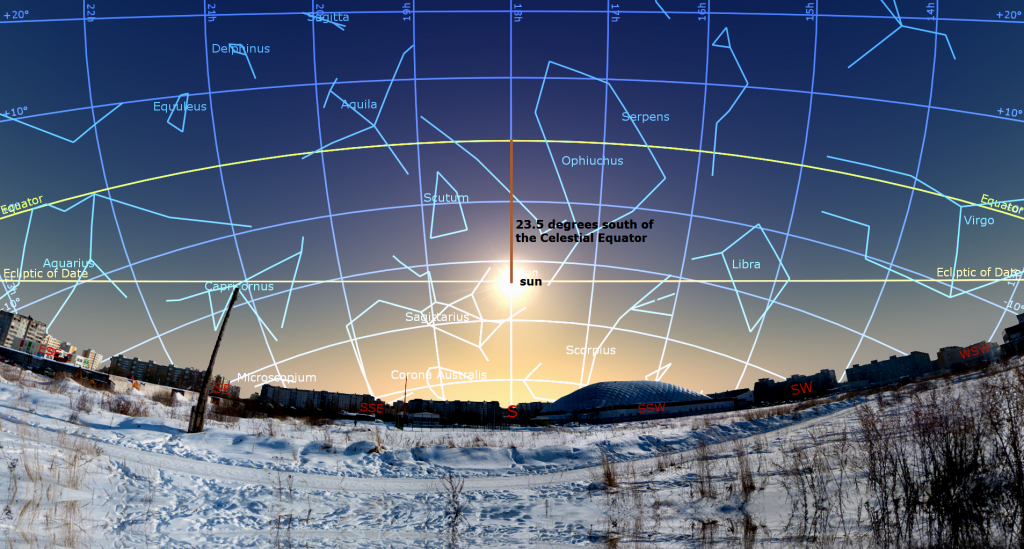
The sunlight that northerners get this at time of year is weaker in intensity because it’s spread over a larger area. A flashlight beam looks dimmer when you shine it obliquely at a wall as opposed to directly at it – try it! On the December solstice, the sun will be directly overhead at noon if you live along the 23° 26’ 11.2” S latitude ring, otherwise known as the Tropic of Capricorn. The sunlight’s intensity weakens more and more as you travel farther from that latitude. (The Tropic of Cancer works the same way for the Southern Hemisphere, but on the June solstice.) In antiquity, when those tropics became understood by astronomers/astrologers, the sun resided in those two constellations on the solstices. The precession (or slow wobble) of the Earth’s axis of rotation shifts the celestial positions of the sun at the solstices and equinoxes, and varies the precise latitude of the two tropics.
Fewer daylight hours and weaker sunlight results in less received solar energy (insolation) and therefore colder temperatures! It is not the case, as some people think, that days are colder in winter because Earth is farther from the sun (a position called aphelion). That event happens every year in early July. On the contrary – Earth’s minimum distance from the sun (perihelion) occurs every January 4, give or take a day.
After Wednesday, northern daylight hours will slowly start to increase again. For our friends in the Southern Hemisphere, the sun will attain its highest noon-time culmination for the year on the December solstice, and kick off their summer season. Their winter will commence six months from now, at the June solstice.
Some scholars think that Christmas was deliberately scheduled close to the winter solstice, and Easter close to the vernal equinox, because the early non-Christian “pagans” were already holding celebrations at that time to mark the astronomical changing of the seasons.
Ursids Meteor Shower
Last week I described here how meteor showers work and some tips for seeing them.
The annual Ursids meteor shower, produced by debris dropped by periodic comet 8P/Tuttle, runs from December 13 to 24. The short-duration shower will peak while Earth is traversing the densest part of the debris field on Thursday afternoon, December 22 in the Americas. Since meteors require a dark sky, the best time to watch for them will be the hours before dawn on Thursday morning and again after dusk that night – but expect to catch fewer than the typical peak rate of 5 to 10 meteors per hour. True Ursids will appear to travel away from a position in the sky above Polaris in the Little Dipper (more formally known as Ursa Minor, the Little Bear), but the meteors can appear anywhere in the sky. This year’s shower peak will be moonless, allowing fainter meteors to be seen.
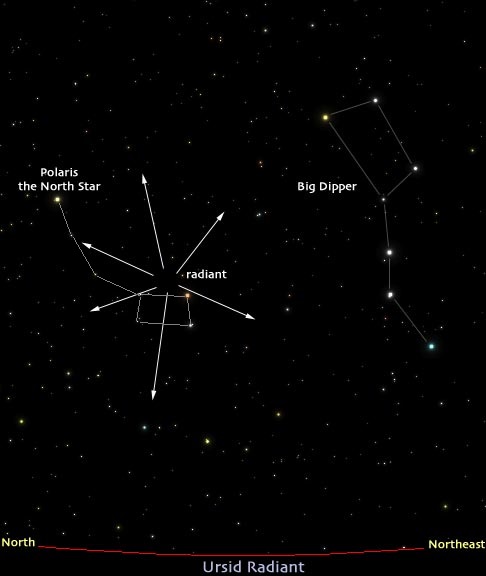
The media tend to promote meteor showers on their peak night – but my Skylights readers know that it’s worth stepping outside for a look on the surrounding nights. I’d rather see fewer meteors on a clear night, than none at all on a cloudy peak night! Do check the weather, though – as you can’t see meteors in cloudy skies. Good luck!
The Moon
If you are lucky enough to experience cloud-free skies, this is the best week of the lunar month worldwide to head outside with your binoculars and telescopes in search of winter’s deep sky delights. The moon will be completely absent from the evening and midnight sky until the coming weekend.
Tonight (Sunday) the moon’s pretty crescent will rise at about 3 am local time Monday morning, joining the bright, white star Spica in Virgo (the Maiden) in the southeastern sky until almost sunrise. On Tuesday morning, the moon will occupy Libra (the Scales). Early risers on Wednesday morning can look for the slender crescent moon shining just below (or celestial southeast of) the medium-bright star Dschubba (or Delta Scorpii). That star sits in the middle of the scorpion’s line of claw stars. Keep an eye out for Earthshine slightly brightening the rest of the moon’s disk.
The old moon will fade from view while it approaches the sun on Thursday – unless you live close to the equator. The moon will reach its new moon phase on Friday, December 23 at 5:17 am EST, 2:17 am PST, or 10:17 GMT. At that time our natural satellite will be located in Sagittarius (the Archer), 4.5° south of the sun. While new, the moon is travelling between Earth and the sun. Since sunlight can only reach the far side of the moon, and the moon is in the same region of the sky as the sun, the moon becomes unobservable from anywhere on Earth for about a day (except during a solar eclipse).
After sunset on Saturday, December 24 the moon will return to visibility – appearing as a very slender young crescent shining a slim palm’s width to the left (or 5° to the celestial southeast) of Venus and Mercury. On Sunday evening, Christmas Day, the moon’s eastward orbital motion will shift it well to the upper left of those planets and allow it to remain visible below Saturn and the stars of Capricornus (the Sea-Goat) as the sky darkens.
The Planets
The inner planets Mercury and Venus will have slid far enough east of the sun to become visible this week. Look for the duo shining just above the southwestern horizon after sunset, with twenty times brighter Venus positioned a palm’s width to Mercury’s lower right (or 6° to the celestial west). Be sure to wait until the sun has completely disappeared before searching for them in binoculars.
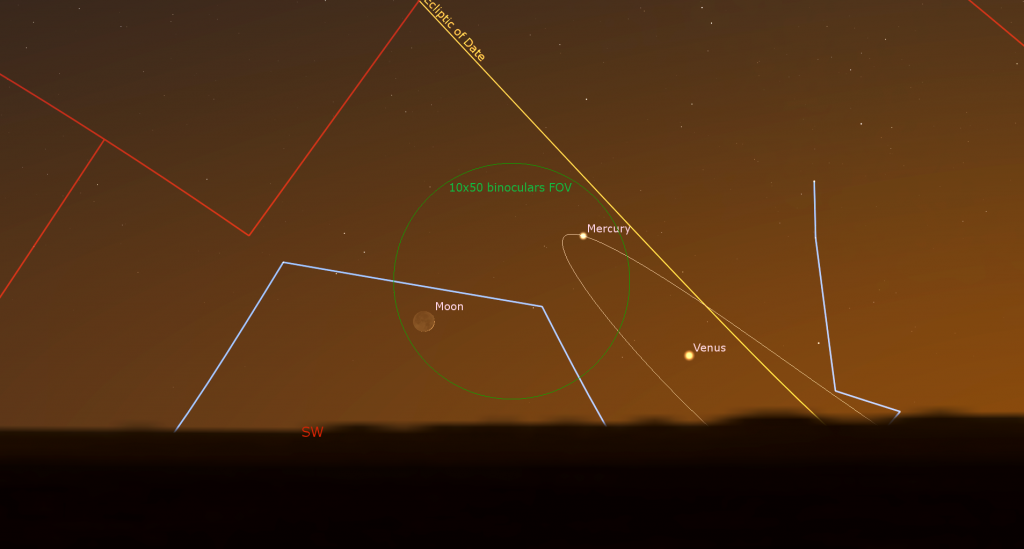
Extremely bright Venus will continue to swing away from the sun and climb higher into evening through winter and spring. For now, it will show a nearly fully round disk in telescopes. On the other hand, Mercury will reach its widest separation of 20 degrees east of the Sun, and maximum visibility for its current evening apparition on Wednesday, and then it will sink sunward again. With Mercury positioned just below the tilted evening ecliptic, this week’s display of the planet will be a relatively good one for both Northern and Southern Hemisphere observers. The optimal viewing times at mid-northern latitudes will start around 5 pm local time. Viewed in a telescope this week, Mercury will exhibit a waning, slightly gibbous phase.
Between sunset and about 5:45 pm local time, all the planets will be above the horizon. Mars, Jupiter, Saturn, and Venus will form a 140 degrees-long arc across the sky, tracing out the plane of our solar system. Uranus, Neptune, and a couple of major asteroids will be strung between them.

The earliest sunsets of the year arrived last week. The dinnertime darkness will allow the yellowish dot of Saturn to become visible in the lower part of the southwestern sky by about 5:30 pm local time. Take a look at magnitude -0.8 Saturn as soon as you can find it in your telescope because it will look less crisp as it drops into thicker air during mid-evening. It’ll set at about 9 pm local time. Saturn will be shining just to the right (celestial northwest) of the medium-bright tail stars of Capricornus (the Sea-Goat), Deneb Algedi on the upper left (celestial east) and Nashira on the lower right (celestial west). Over the next couple of weeks, you’ll be able to use binoculars or your sharp eyesight to see Saturn’s easterly prograde motion shift the planet past them. I plotted Saturn’s long-term path here.
Cold Weather Astronomy Tip: If you plan to use your telescope on winter evenings, set it outside in a safe location (even an unheated garage or car trunk will do) for at least a couple of hours ahead of time. That will allow the air trapped inside it to chill down to ambient, reducing the turbulent “tube currents” that distort the images. Leave all the lens caps in place until viewing time to prevent frosting on the glass elements. And put those caps back on before bringing it back inside at the end of the session. Better yet, zip it into its case or snug a plastic bag around it while still outside. That way, the warm house air cannot condense on it.
On a night with steady air, quality 10×42 binoculars (and larger) should show Saturn and its rings as a tiny oval. Even a small telescope can show the planet’s subtly banded globe encircled by its glorious rings. See if you can make out the Cassini Division, a narrow, dark gap that separates Saturn’s main inner ring (named B) from its bright outer ring (named A). Any telescope should show that a segment of Saturn’s rings adjacent to the eastern limb of the planet is in shadow. That dark wedge is getting a little smaller every night. Where it sits will depend on how your telescope flips the view.
A small telescope can also pick up several of Saturn’s moons – especially its largest, brightest moon, Titan! From here on Earth, Saturn’s axial tilt of 26.7° lets us see the top of its ring plane, and allows its brighter moons to array themselves all around the planet. (In contrast with Saturn, Jupiter’s axis is only tilted by 3°, so Jupiter’s moons show in a line running through that planet’s equator.)
Titan never wanders more than five times the width of Saturn’s rings from the planet. The much fainter moon named Iapetus can stray up to twelve times the rings’ width during its 80-day orbit of Saturn. The next brightest moons Rhea, Dione, Tethys, Enceladus, and Mimas all stay within one ring-width of Saturn. During evening this week, Titan will migrate counter-clockwise around Saturn, moving from below (or celestial south) of Saturn tonight (Sunday) to the right (or celestial northwest) of Saturn next Sunday. (Remember that your telescope might flip that view around.) How many of the moons can you see in your telescope?
Extremely bright, magnitude -2.5 planet Jupiter, which will look 20 times brighter than Saturn, will become visible in the south after 5 pm local time. Jupiter will look best in a telescope when it climbs highest (or culminates) due south around 6:30 pm local time, and then it will set in the west shortly after midnight.
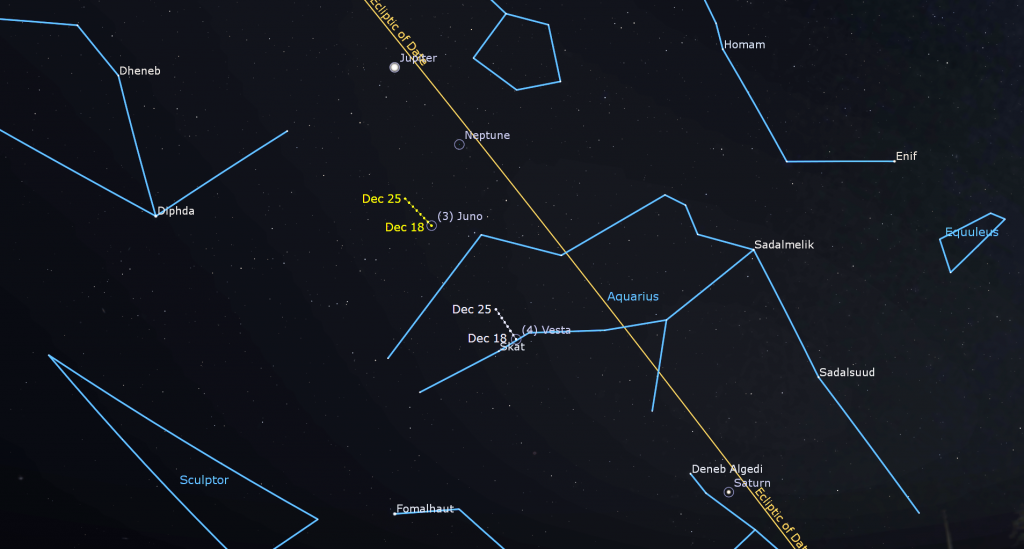
Your binoculars should be able to show you Jupiter as a small disk bracketed by its line of four Galilean moons named Io, Europa, Ganymede, and Callisto. Those moons complete orbits of the planet every 1.7, 3.6, 7.2, and 16.7 days, respectively. If you see fewer than four moons, then one or more of them is crossing in front of or behind Jupiter, or hiding in Jupiter’s dark shadow – or two of the moons are very close together or occulting one another. The moons’ arrangement varies each night.
Once the sky is fully dark, use your binoculars to spy a pentagon-shaped ring of low-brightness stars shining about a fist’s diameter to the upper right of Jupiter. They make up the western head of Pisces (the Fishes). The brighter stars of the Great Square of Pegasus (the Flying Horse) will be visible, even with your unaided eyes, about 2.5 fist diameters above Jupiter. The moonless nights will make seeing those stars easier this week.
Even a small, but decent quality telescope can show you Jupiter’s dark belts and light bands, which are aligned parallel to its equator. With a better grade of optics, Jupiter’s Great Red Spot, a cyclonic storm that has raged for hundreds of years, becomes visible for several hours when it crosses the planet every 2nd or 3rd night. For observers in the Americas, that GRS will cross Jupiter’s disk in early evening on Monday, Thursday, and Saturday, and late on Sunday, Wednesday, and Friday evening. If you have any coloured filters or nebula filters for your telescope, try enhancing the spot with them.
The round, black shadows of Jupiter’s Galilean moons are visible through a good backyard telescope when they cross the planet’s disk. On Sunday evening, December 18 the small shadow of Europa will cross the southern hemisphere of the planet, with the Great Red Spot, from 10:25 pm to 12:45 am EST. Io’s shadow will cross Jupiter’s equator on Saturday night from 10 pm to 12:05 am EST. Don’t forget to adjust these quoted times into your own time zone.
In mid-evening this week, magnitude 7.9 Neptune will be located a generous palm’s width to the lower right (or 7° to the celestial west-southwest) of Jupiter, about halfway towards the medium-bright star Phi Aquarii. Neptune’s apparent disk size is 2.3 arc-seconds (20 times smaller than Jupiter’s). Try to view Neptune while it is highest, around 6 pm. The large asteroids designated (4) Vesta and (3) Juno are currently following Jupiter. They are located near the knee stars of Aquarius (the Water-Bearer).

Mars will continue to be visible all night long. Although it has already started to diminish in brightness after the December 7-8 opposition night, its bright, magnitude -1.6 reddish dot will catch your eye in the eastern sky after dusk. Mars will be positioned to the upper left of the very bright, reddish star Aldebaran, which marks Taurus the bull’s eye, and to the lower left of the Pleiades star cluster, which is the prominent little clump of stars above Aldebaran. Early risers can spot Mars above the western horizon before sunrise. Until mid-January, Mars will travel towards the Pleiades.
Mars will still be an impressive sight in backyard telescopes this week, showing an apparent disk diameter of 16 arc-seconds (Jupiter’s disk spans about 42 arc-seconds and the full moon is 1,800 arc-seconds wide). Mars’ Earth-facing hemisphere this week will display its bright northern polar cap – visible as a small bright spot along the planet’s edge, the dark Mare Erythraeum, Chryse, and Acidalia Planitia regions, and the expansive lighter-toned Tharsis region. The polar cap might look larger or stretched out along Mars’ edge if you are viewing it through turbulent air or a mis-collimated telescope. Use mya labelled image or the terrific Mars mapping tool created by Ade Ashford at http://www.nightskies.net/skyguide/mars/mars.html. Use the drop-down menu to select from two views of Mars, labelled or not.
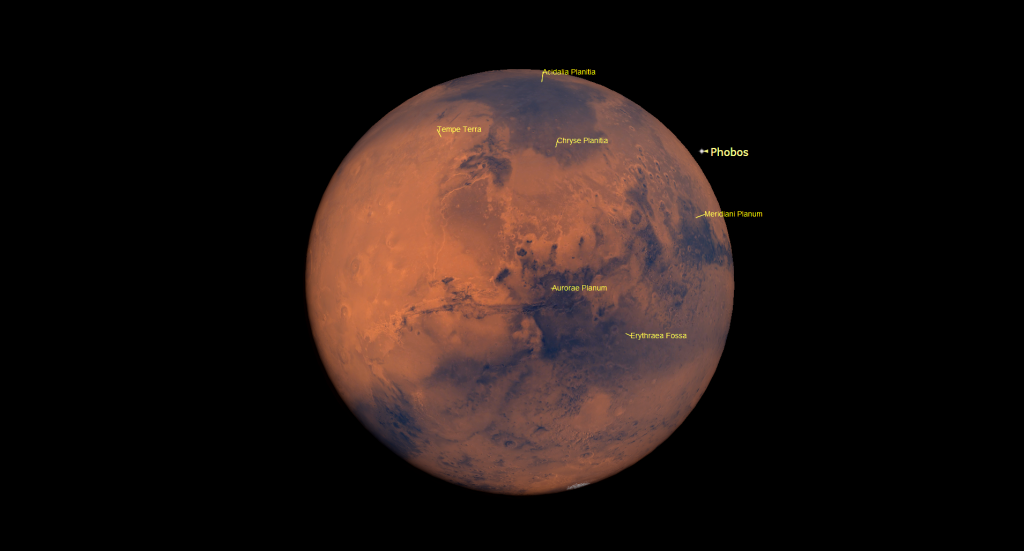
Mars takes about 20 minutes longer than Earth to rotate once fully on its axis. So viewing the planet at the same time on subsequent nights will show roughly the same view of it, but with the surface markings shifted by about 5°. If you have coloured filters for your telescope, see if the blue, orange, or red one improves the view. If you find Mars is too bright, use a moon filter on it.
The distant blue-green planet Uranus is located about 35% of the way from Mars towards Jupiter, and about 1.5 fist widths to the upper right (or 15° to the celestial west-southwest) of the Pleiades star cluster. Closer guideposts to Uranus are several medium-bright stars, including Botein (or Delta Arietis), Al Butain II (or Rho Arietis), and Sigma Arietis, which will appear several finger widths from the planet. Those stars mark the feet of the Aries (the Ram). Magnitude 5.7 Uranus will already be high enough for telescope-viewing, in the middle part of the eastern sky, after dusk this week. It will climb to its highest point in the southern sky around 9 pm local time.
Christmas Stars?
Sirius, the brightest star in Canis Major (the Big Dog) and the brightest star in the entire sky (not counting the sun), will appear above the southeastern horizon around 8 pm local time this week. It’s hard to miss Sirius once it clears the trees and rooftops. The star will climb to its highest point, in the lower part of the southern sky, after midnight. If you are walking through your darkened house in the middle of the night, Sirius might catch your eye out a window because it never climbs very high. Sirius is a hot, blue-white coloured, A-class star located a mere 8.6 light-years away from the sun. Its extreme brightness and its low position in the sky combine to produce spectacular flashes of color as it twinkles. A very large telescope may allow you to see Sirius B, a faint white dwarf companion star located just 10 arc-seconds east of Sirius.

Once Venus begins to gleam in the evening sky this winter, it’ll be easy to imagine that sky-watchers of old could be captivated by Venus’ brilliance and name it a “Christmas Star”. But Venus puts on those celestial showings, in the east before sunrise or in the west after sunset, every two or three years – hardly a rare occurrence. The event that may have spawned the biblical story of wise men following a star in the east, was a planetary conjunction of Mercury, Jupiter, Mars, and Venus that occurred in the eastern pre-dawn sky in early November of the year 1 CE. In fact, on one of those mornings, Venus and Jupiter were so close together that they might have looked like a single, extra-bright object!

For about a week, all four bright planets were grouped into a stubby line that spanned less than four fingers widths in length. The next time you see bright Venus, hold up your hand beside it and imagine how impressive those other planets gathered around her would have looked.
A Peek at Perseus
Fall and winter evenings host the constellations involved in the Greek mythology story of Perseus (the Hero) and Andromeda (the Princess). Last month I told part of Andromeda’s story and toured her stars and deep sky objects here. Last week, I described her mother, Queen Cassiopeia’s constellation here. For this lovely moonless week, let’s look at the Hero Perseus and his story. Once upon a time…
Andromeda was the beautiful daughter of Queen Cassiopeia and King Cepheus of Ancient Aethiopia. After her mother angered the Nerieds (Sea Nymphs) by boasting of Andromeda’s unrivaled beauty, the god of the sea Poseidon (aka Neptune) sent Cetus, the Sea-monster to ravage Aethiopia’s coast. An oracle told King Cepheus that his only solution was to sacrifice Andromeda to Cetus. So she was chained to rocks by the sea-shore.
Meanwhile, King Polydectes of Seriphos had sent the hero Perseus to retrieve the head of the snake-headed Gorgon named Medusa. Before hunting Medusa, Perseus was given some magical gifts to aid him in his quest, including winged silver sandals called the Shoes of Swiftness. Immediately after slaying Medusa by cutting off her head, he flew into the air to avoid her two angry sisters. While hovering there, some of the gorgon’s blood dripped onto the seashore below. Poseidon, god of the Sea, mixed the blood with some sea foam, and the magical flying horse Pegasus, whose name is related to the Greek word for wellspring “pegai”, sprang from the sea.
Perseus, using his winged sandals to fly back to Seriphos, happened to spot Andromeda just as Cetus was about to take her. She must have been beautiful indeed, because he instantly fell in love with her, slew the beast, and freed her from her chains. After more adventures, including one in which Perseus accidently killed his evil grandfather to fulfill a prophecy, the couple sailed to Argonis, where they raised a family of many children. Hercules was descended from them.
Perseus is one the 48 ancient constellations described by the Greek astronomer Ptolemy in the 2nd Century. His stars are centred midway between the Celestial Equator and Polaris – so part of him is circumpolar for mid-northern latitude observers. The entire constellation can be seen as far as 30° S latitude on Earth, but only during evenings from November to January, when he peeks above the northern horizon there.

Perseus’ main stars are enclosed in a square spanning about 26° north-to-south and 22° east-to-west. A peninsula appended to his northwestern corner adds to his territory. Perseus is bordered by the prominent constellations of Taurus and Aries on the south, Auriga on the east, and Andromeda’s mother Cassiopeia to the northwest. Triangulum and Andromeda’s feet are due west of him. The faint stars of Camelopardalis (the Giraffe) lay to his northeast.
On late December evenings Perseus is located very high in the eastern sky. The easiest way to identify the constellation is to look for Perseus’ brightest star Mirfak, which shines midway between the W of Cassiopeia and the even brighter, yellowish star Capella in Auriga below it. Once you have Mirfak, which represents the hero’s heart, look for two more stars spaced out towards Cassiopeia. They trace out his neck and head. To the lower right of Mirfak, you’ll see a lengthy chain of medium-bright stars that arc downwards towards the bright Pleiades star cluster. That’s his torso and eastern leg. His western leg is composed of another chain of stars that begins at a grouping representing Medusa’s head. (She’s slung on his hip or held in his western hand.) That leg curves northeast, passes above Mirfak, and converges towards his head. In the sky, the two arcs appear as a narrowing wedge which points toward the queen’s W.
Since the two rows of stars resemble legs, many cultures saw a human figure in them. In contrast, Asian astronomers saw a boat’s keel formed by the lower (eastern) curve of stars, and the Romanians saw a mighty axe called Barda.
Mirfak or Alpha Persei (α Per) is a golden, F5-class supergiant star located about 510 light-years from Earth. The name has been shortened from the Arabic expression Marfik al Thurayya, “the Elbow Nearest to the Many Little Ones”, referring to the Pleiades star cluster by their Arabic name, al Thurayya. Mirfak is several thousand times more luminous than our sun and about 42 times larger. It is an elderly, yellow supergiant star that has evolved out of its blue phase and is now fusing helium into carbon and oxygen in its core. Some ancient star charts labelled Mirfak as Algenib, from Al Janb “the Side” – but that name is nowadays used for Gamma Pegasi, the southeastern star in Pegasus’ Great Square.
Mirfak shines at the upper left (northwestern) edge of a large and loosely scattered cluster of about 100 hot, bright, blue-white B and A-class stars known as the Alpha Persei Moving Group, the Perseus OB Association, and Melotte 20. Those stars are siblings of Mirfak – born from the same molecular hydrogen cloud about 41 million years ago – and now travelling through the galaxy together with Mirfak. The open star cluster, which is sprinkled across 3 degrees of the sky, can be seen with unaided eyes, and looks wonderful in binoculars.
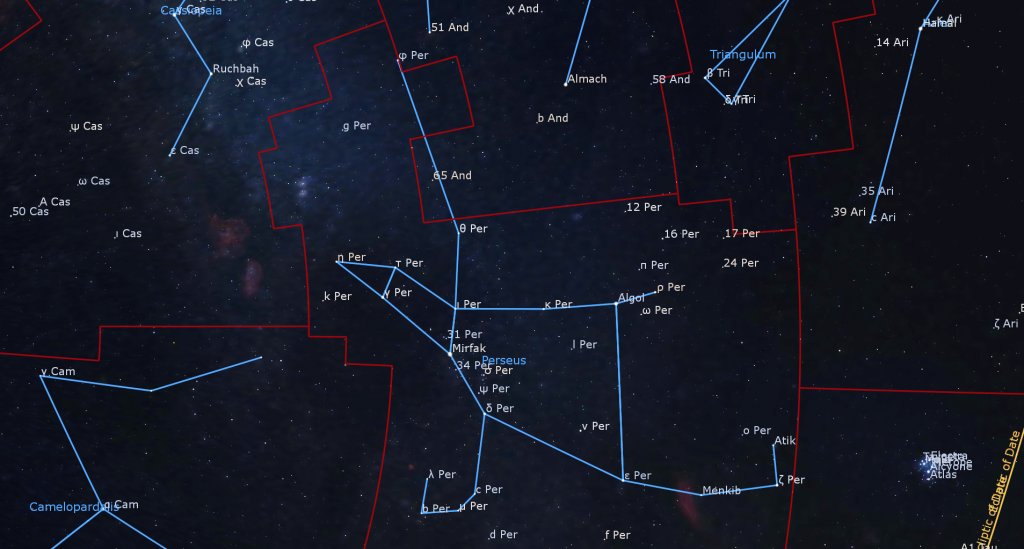
Let’s inspect Perseus’ lower (easterly) chain of stars. The medium-bright star positioned several finger widths below (southeast of) Mirfak is Delta Persei (δ Per). It’s an outlying member of the OB Association. In a telescope, Delta Persei will split into a close double star pair. Some star charts depict Delta as Perseus’ eastern shoulder. A chain of half-as-bright stars, each about a thumb’s width apart, form his arm, which curves downwards to the east. In order, those stars are c Persei, Mu Persei (μ Per), b Persei, and Lambda Persei (λ Per).
Two relatively bright open star clusters named NGC 1528 and NGC 1545 are positioned within a finger’s width of the star b Perseii – one to the upper left and one below it, respectively. Together, they are named the m & m Double Cluster. Less than a finger’s width above (north of) Lambda Persei sits a beautiful clump of glowing gas with embedded stars called the Fossil Footprint Nebula or NGC 1491. In long exposure images it reaches the size of the full moon. Several more star clusters are in the same area. Scan around with your binoculars!
Resuming our tour back at Delta Persei, look nearly a fist’s diameter to the lower right for the star Epsilon Persei (ε Per), and then continue right for a few more finger widths to the less-bright star Menkib or Xi Persei (ξ Per), so named from the expression Mankib al Thurayya “shoulder of the Pleiades”. Menkib is a blue supergiant star, 12,700 times brighter than our sun. Its photosphere’s temperature of 35,000 K makes it one of the hottest stars you can see with your unaided eyes. The radiation from Menkib is causing the hydrogen gas in a nearby cloud to glow with red light, producing the gorgeous California Nebula, or NGC 1499. The very faint, elongated nebula, which stretches up-down just to the left of Menkib, covers a patch of sky larger than 1 x 5 moon diameters! A palm’s width below (or 6.4 degrees to the celestial east) of Menkib is a much smaller, but brighter glowing gas region called the Northern Trifid Nebula (NGC 1579), so-named because strips of dark foreground dust have separated the gas into lobes.
From Menkib we slide right (south) by several finger widths to Zeta Persei (ζ Per), a bright star that marks Perseus’ eastern foot. Zeta is about 750 light years from us. In a telescope, look for two small stars huddled together close to the lower right of it – its travelling companions. Two finger widths to the upper right (west) of Zeta, look for the medium-bright, white star named Atik or Omicron Persei (ο Per). Its name comes from Al Atik “the shoulder” – although I see it as the wing of his sandal.
Atik is part of a multiple star system. Under high magnification in a telescope it splits into a close together pair of stars. Binoculars should show you a little clump of stars below the pair, an open cluster named IC 348. A star named V718 Persei inside of IC 348 appears to be periodically eclipsed by an orbiting giant exo-planet every 4.7 years. Long exposure photos will reveal a large halo of blue nebulosity around both Atik and that cluster. Similar to the Pleiades, the glow is starlight scattering from interstellar dust in the foreground. The sky between Zeta Persei and Atik is sprinkled with little stars that show well in binoculars. Another pretty knot of glowing gas and stars named the Embryo Nebula (NGC 1333) is located a few finger widths to the upper right of Atik.
Starting back at our home base, bright Mirfak, let’s now travel up to Perseus’ head, towards Cassiopeia. Four finger widths to the upper left of Mirfak we find the medium-bright, yellow Gamma Persei (γ Per), a sun-like star. Some charts label it Al Fakhbir or Alphecher, from the Arabic for “the Excellent One”. Gamma is an eclipsing binary star system that diminishes a little bit in apparent brightness for two weeks every 14.6 years. Thinking of Gamma as Perseus’ eastern eye, or ear, the less-bright, orange-tinted star shining a few finger widths to Gamma’s upper left marks the top of the hero’s head. That’s Eta Persei (η Per), sometimes called Miram. It’s located about 1,300 light-years away from us. Look for a faint white companion star nearby. Meteors from the annual Perseids Meteor Shower appear to radiate from a point in the sky near this star because Earth is traveling in that direction at the shower’s peak.
The sky several finger widths to the upper left of Miram contains the bright Double Cluster. Those two open star clusters, each 0.3 degrees across and approximately 0.45 degrees apart, form a spectacular one-finger-wide sight in binoculars or a telescope at low magnification. (That’s twice the width of the full moon!) The higher, more westerly cluster NGC 869 is slightly closer to Cassiopeia. It is more compact, and contains more than 100 white and blue-white stars. NGC 884, the lower, easterly cluster, is a bit sparser and contains a handful of 8th magnitude golden suns. Zoom in close with your telescope to see their double stars, mini-asterisms, and dark lanes of missing stars. The two clusters formed inside the Perseus Arm of our Milky Way galaxy, about 7,300 light-years from the sun. Their visual brightness has been dramatically reduced by opaque interstellar dust in the foreground.
Shifting to the right (celestial south) by a few finger widths from Eta, we find the hero’s western eye, or ear – the star Kerb or Tau Persei (τ Per). As with Gamma below it, Tau is a G8-class, sunlike star. It has the same familiar yellowish tint, but shines only half as brightly as Gamma. It’s another eclipsing binary system, with a period of 4.15 years. Use your binoculars to look for a star located a finger’s width to the lower right of Tau Persei. In a telescope, that star divides into a close together pair, the double star named Struve 331 or Σ331! (The name comes from father and son astronomers Friedrich Georg Wilhelm von Struve and Otto Wilhelm von Struve, who catalogued double stars.)
Continuing to the right from Kerb brings us to Iota Persei (ι Per). It’s another yellow star, positioned about two finger widths above Mirfak. Extend the line from Mirfak upwards through Iota and beyond to trace out a long, bent row of stars, all of about the same brightness, that represent Perseus’ western arm or outstretched sword. It continues with Theta Persei (θ Per) about a palm’s width above Mirfak. From theta, look a few finger widths to the upper left for the widely spaced trio of stars named 64, 65, and 66 Andromedae (the border with Andromeda jogs left and right in this area). After passing a solo star named 6 Persei, Perseus’ arm ends at the medium-bright, white star Phi Persei (φ Per) a palm’s width beyond the trio. That’s a total length of 1.4 fist diameters (14 degrees). Phi has a fainter reddish companion sitting just to the upper right it. A finger’s width below Phi (or 0.9 degrees to the north-northwest) you’ll find Messier 76, the Little Dumbbell Nebula. It’s a planetary nebula – the corpse of a star with the mass of our sun that blew off its outer layers at the end of its life. This little gem, 5600 light-years distant, can be seen in a backyard telescope under dark skies.
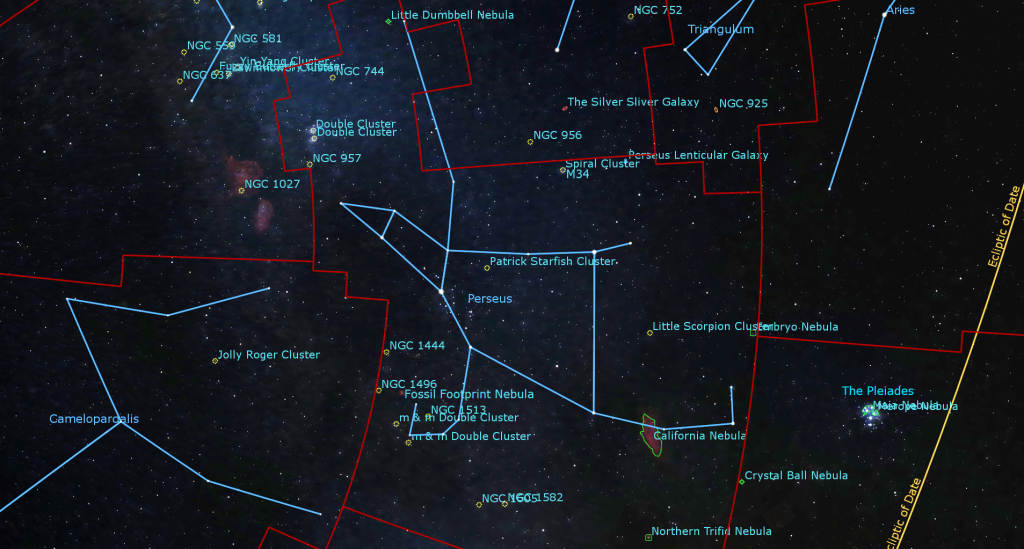
Returning your steps back to Iota Persei, shift your gaze four finger widths to the right (south) to yellow-orange Kappa Persei (κ Per). At 112 light-years away, it’s among Perseus’ closest stars to Earth. Its traditional name Misam comes from the Arabic miʽṣam “wrist”. It has evolved from a sunlike G-class star into a red giant fusing helium in its core. It may actually have been ejected from the Pleiades or Hyades clusters to the south! NGC 1245, a nice open cluster, the same size as the moon, is located just a finger’s width below the midpoint between Iota and Kappa. Its nickname, the Patrick Starfish Cluster, comes from TV’s SpongeBob Squarepants.
The bright star positioned a few finger widths to the right (or 4 degrees to the celestial south of) Kappa is Beta Persei (β Per), better known as Algol, from the Arabic Ra’s al-Ghul, which means “the Demon’s Head”. The star represented the god Horus in Egyptian mythology and was Rosh ha Satan “Satan’s Head” in Hebrew. Before we focus our attention on Algol and the stars forming Medusa’s head, aim your binoculars or telescope four finger widths above (celestial northwest) Algol and look for the big and bright open star cluster Messier 34, also called the Spiral Cluster and NGC 1039. Many of its brightest stars are arranged in curved chains, hence the nickname.
The area around Algol is littered with distant galaxies! A galaxy cluster named the Perseus Cluster or Abell 426 contains thousands of them, including an active peculiar galaxy named NGC 1275 or Perseus A that is the brightest object in X-ray wavelengths in the entire sky, despite it being more than 225 million light-years away! NGC 1275 and some of the galaxies near it are visible in larger backyard telescopes and long exposure photographs. The cluster is centred two finger widths to the lower left (celestial east-northeast) of Algol.
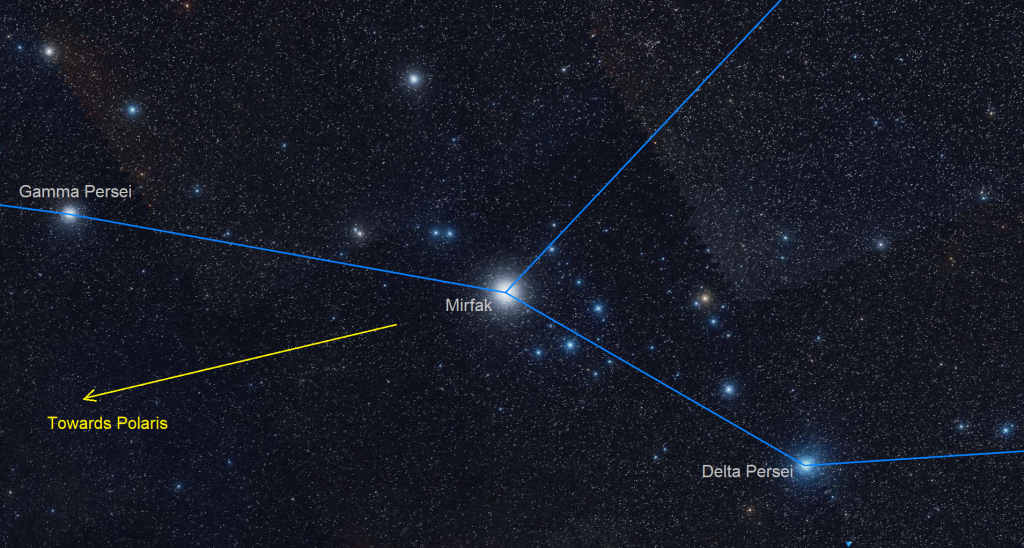
Algol is among the most accessible variable stars for beginner skywatchers. Like clockwork, this star’s visual brightness dims noticeably once every 2 days, 20 hours, and 49 minutes. That happens because a dim companion star orbiting nearly edge-on to Earth crosses behind the much brighter main star. Once the eclipse begins, the light we see steadily drops in brightness for five hours. Then it ramps up again during another five hours – until the eclipse is over. Algol is the archetype for all eclipsing binary star systems.
Algol represents the pulsing eye of Medusa the Gorgon, whose severed head Perseus is carrying, hence its scary nickname. Yet another name for Algol is Gorgonea Prima “the First Gorgon”. The star that sits two finger widths to the right of Algol is Gorgonea Tertia “the Third Gorgon” or Rho Persei (ρ Per). In binoculars, that star appears markedly red due to its cool, M4-class spectrum. Gorgonea Secunda “the Second Gorgon” and Gorgonea Quarta “the Fourth Gorgon” are the stars Pi Persei (π Per) and Omega Perseii (ω Per). They are located to the upper right and lower right of Algol, respectively. The four Gorgonea stars combine to form Medusa’s box-shaped head. Algol is located about 90 light-years from Earth – but the other three stars are all about 300 light-years distant.
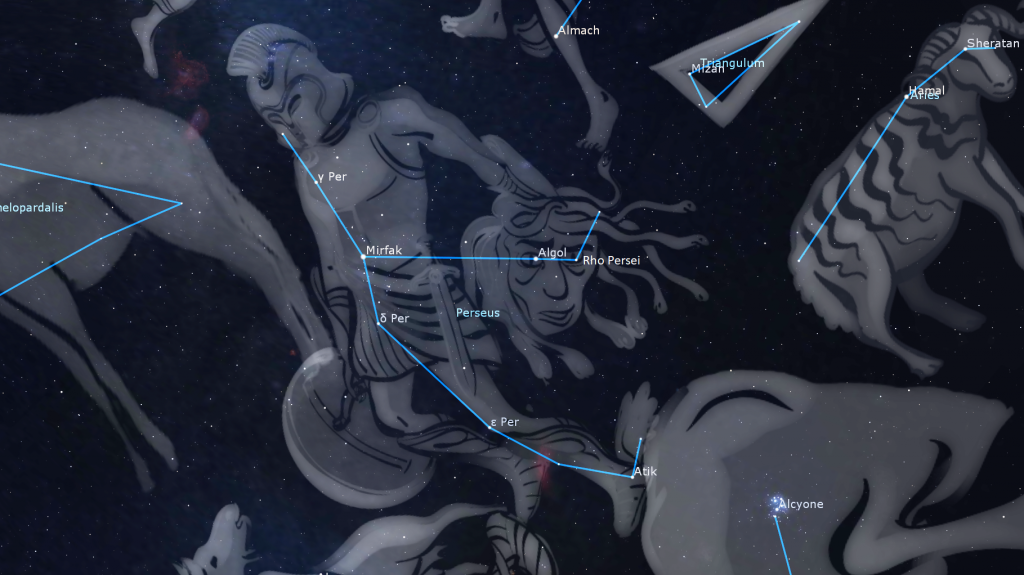
The easiest way to detect Algol’s variability is to note how bright that star looks compared to other, non-varying stars near it. When it isn’t dimmed, Algol is as bright as Almach, the bright star located a fist’s diameter above Algol (or celestial west) in Andromeda. Although Gorgonea Tertia is somewhat variable, too – it’s pulsing due to old age – Algol shines at about the same brightness while dimmed.
This will be a terrific week to explore Perseus, Andromeda, Cassiopeia, and the other story characters Cepheus and Pegasus, in binoculars and backyards telescopes.
Public Astro-Themed Events
Every Monday evening, York University’s Allan I. Carswell Observatory runs an online star party – broadcasting views from four telescopes/cameras, answering viewer questions, and taking requests! Details are here. They host in-person viewing on the first clear Wednesday night each month. On Wednesdays they stream views online via the observatory YouTube channel. Details are here.
Most organizations are taking a well-earned break.
My free, family-friendly Insider’s Guide to the Galaxy webcast with Samantha Jewett of RASC National returns on Tuesday, January 17 at 3:30 pm EST. We’ll select a fun topic in astronomy, and we’ll highlight the next batch of RASC’s Finest NGC objects. You can find more details and the schedule of future sessions here.
Keep looking up, and enjoy the sky when you do. I love questions and requests. Send me some!